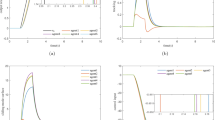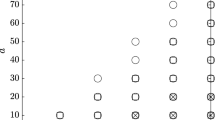Abstract
This paper proposes a systematic design methodology for the Takagi-Sugeno (TS) model based fuzzy state feedback control system with multi-objectives. In this investigation, the objectives are set to be guaranteed stability and pre-specified transient performance, and this scheme is applied to a nonlinear magnetic bearing system. More significantly, in the proposed methodology, the control design problems that consider both stability and desired transient performance are reduced to the standard LMI problems. Therefore, solving these LMI constraints directly (not trial and error) lead to a fuzzy state-feedback controller such that the resulting fuzzy control system meets the above two objectives. Simulation and experimentation results show that the proposed LMI-based design methodology yields not only maximized stability boundary but also the desired transient responses.
Similar content being viewed by others
References
Chilali, M. and Gahinet. P., 1996, “H2AD7;Design with Pole Placement Constraints: An LMI Approach, “IEEE Trans. Automatic Control, Vol. 41, No. 3, pp. 358–367.
Gahinet, P, Nemirovski, A., Laud, A. and Chilali, M, 1995,The LMI Control Toolbox, The Math Works, Inc., 1995.
Hong, S. K. and Langari, R., 1997, “Experiments on Fuzzy Logic Based Control of a Magnetic Bearing System,“ inProc. North American Fuzzy Information Processing Society (Syracuse, New York), pp. 90–95.
Hong, S. K. and Langari, R., 1999, “Fuzzy Modeling and Control of a Nonlinear Magnetic Bearing System,”Journal of Intelligent & Fuzzy Systems, Vol. 7, No. 1, pp. 335–346.
Hong, S. K. and Langari, R., 2000, “Robust Fuzzy Control of a Magnetic Bearing System Subject to Harmonic Disturbances,”IEEE Trans, on Control System Technology, Vol. 8, No. 2, pp. 366–371.
Hong, S. K. and Langari, R., 2000, “An LMI-Based Hinfinitive Fuzzy Control System Design with TS Framework,”Information Sciences: An International Journal, Vol. 123, No. 1, pp. 163–179.
Takagi, T. and Sugeno, M., 1985, “Fuzzy Identification of Systems and its Application to Modeling and Control,“IEEE Trans. Syst., Man, Cybern., Vol. 15, pp. 116–132.
Tanaka, K. and Sugeno, M., 1992, “Stability Analysis and Design of Fuzzy Control systems,”Fuzzy Sets Syst., Vol. 45, No. 2, pp. 135–156.
Tanaka, K. and Sano, M., 1994, “A Robust Stabilization Problem of Fuzzy Control Systems and its Application to Backing up Control of a Truck-Trailer,”IEEE Trans, on Fuzzy Systems, Vol. 2, No. 2, pp. 119–134.
Wang, H. O., Tanaka K. and Griffin, M. F., 1996, “An Approach to Fuzzy Control of Nonlinear Systems: Stability and Design Issues,“IEEE Trans, on Fuzzy Systems, Vol. 4, No. 1, pp. 14–23.
Zhao. J.. Gorez, R. and Wertz, V., 1996, “Synthesis of Fuzzy Control Systems with Desired Performances,”in Proc. IEEE Int. Symp. Intelligent Control, pp. 115–120, Dearborn, MI
Author information
Authors and Affiliations
Corresponding author
Rights and permissions
About this article
Cite this article
Hong, S.K., Nam, Y. An LMI-Based Fuzzy State Feedback Control with Multi-Objectives. KSME International Journal 17, 105–113 (2003). https://doi.org/10.1007/BF02984291
Received:
Revised:
Published:
Issue Date:
DOI: https://doi.org/10.1007/BF02984291




